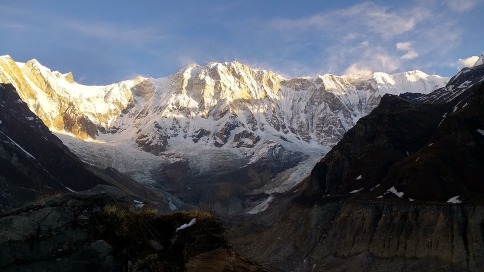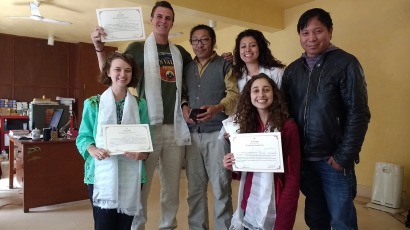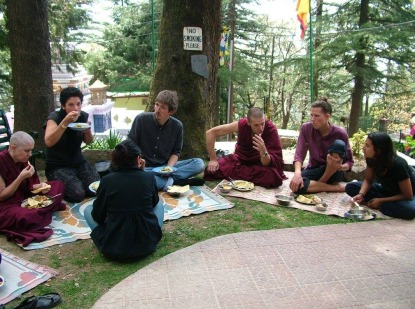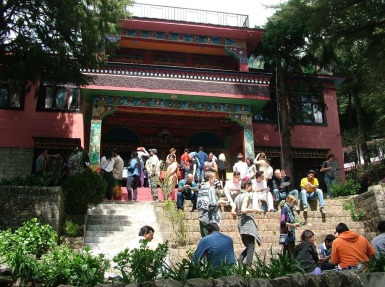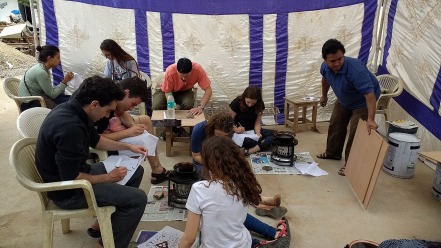|
Bangkok to Krabi (final post)
Bangkok, Thailand |
Bangkok, Thailand
This was it. The last stretch of the trip before we headed back home. The last 10 days in Bangkok and the Southern Islands of Thailand. We got up and packed our bags before heading to the airport around 10:30 am. We went through security and had an hour and a half layover, got on the plane at 1:00 pm and did what we could to relax and contain our excitement for this next segment.
We arrived in Bangkok at around 6:00 pm local time, the flight only taking roughly two or three hours. We went to baggage claim and stepped outside of the airport. A huge wave of humidity hit us, and we all had a look of discomfort on our faces from it. We got taxis and headed to our new temporary home away from home: Tavee Guest House.
Along the way, we noticed the drastic difference from India and Nepal. This was something more familiar, something more modern. Skyscrapers lined the smoothly paved asphalt roads and streetlights helped direct traffic. Billboards showed advertisements for new models of cars and certain signs were dedicated to the memory of the late king.
Once we arrived to the guest house, we were assigned rooms and then headed off to have dinner. We found a restaurant that had live music and pretty good food such as the infamous pad thai. Wandering around afterwards we took in all the new sights and smells and sounds that vibrated deep down to our core. It was breath-taking. We went back to the guest house after a few hours of exploring and eating.

The next morning, Bradford, May, Estelle, and I went to go check out the snake farm. It was an interesting experience with getting to know about the native snakes in Thailand and even having the chance to take a picture with one of the boa constrictors that they had. We had all planned on going to the Bangkok Art and Culture Centre, which is an art museum that is in the main city area. It was quite impressive, seeing the mixed forms of media and artworks that were presented in the galleries and exhibitions on the 9 or 10 levels of the BACC. Some of us went back early while Fiji and Bradford stayed behind to check out the surrounding area. Judith and I wandered around the streets, seeing the sights and visiting a local temple and noticing the differences in Thai architecture compared to Indian and Nepali architecture. How the roofs ended in a more pointed, spike-like tip than a more classical animal head or design similar to it. We headed back after a while and met up with the others to have dinner. We went back to the place that had restaurants with live music and found one that we liked, and ate and hung out for a few hours before heading back to the guest house and going to sleep.

Our next journey would take us on a train to the Southern Islands, filled with gorgeous beaches and tropical landscapes.
We woke up the next morning excited to see the islands. We moved all of our stuff into the storage room of the guest house and most of us headed out to the mall area to get lunch. Shortly after leaving, a thunderstorm rained down upon us, soaking us. Luckily we stayed dry in the taxi as best we could and enjoyed the modern facilities of the mall in Bangkok. Around 5:00 pm, we were all back at the guest house, ready to leave. We headed to the train station and got on the platform. Bradford had told us that these trains would be much nicer than the ones we rode in India. They would provide us with bedding and pillows as well as an amazing view from the large window facing the outside world. We were not disappointed.
Roughly twelve hours later, we would be in the Southern Islands. The anticipation was keeping us awake, but we did manage to get a few hours of sleep.

At 7:00 am, we arrived at Surat Thani Station and got off the train, heavy bags in hand. We were here, finally in the Southern Islands. A place where we could relax and swim and enjoy these last few days of the trip in peace. We took taxis to our guest house. Once we got settled, we headed to the beach to get a longboat to take us to Phra Nang Beach. We spent the next 6 hours there, hanging out on the sand, swimming in the ocean, playing four square, and exploring the caves nearby. Sadly, there were some jellyfish in the water, and most if not all of us got stung, so that was short-lived. Nonetheless, we enjoyed ourselves. We took another longboat back to the mainland and watched the sun set as we rode the waves and witnessed an approaching storm in the distance.
We got back and enjoyed the variety of food that was served at the numerous food stands close to the docks before heading back to the guest house and sleeping. Tomorrow we would be meeting our local director in Thailand/Southern Islands, a man by the name of Sun. Little did we know about the adventures that would follow after meeting this man.

After eating breakfast and packing our bags, we met up with Sun at around 9:30 or 10 in the morning. He has been doing this job for the past 17 years and has a lot of experience with foreigners coming to these islands, to his home.
Sun took us to his farm where we dropped off our bags, and then we headed off to go kayaking and see caves. We were broken up into pairs and paddled our way across the water, seeing the natural wonder of what water can do to rock with time and patience.

We had lunch and then went back to the farm. We all felt exhausted from kayaking, so we slept until dinner was ready. As we have learned to expect, we had a massive feast of delicious food and ate until we hated ourselves. Once we were stuffed, we went to bed satisfied with how our first day went.
The next day, we went with Sun to explore the islands nearby. We spent the day on the boat, going to swimming holes and witnessing the beauty of the ocean and the sun beating down on our skin. It was amazing to behold and quite a calming experience.
We headed back to one of the main islands and got assigned to bungalows, which was probably the fanciest place we have stayed in so far on this trip. For dinner, we were invited to eat with one of Sun’s friends at their house and we ate a bunch of delicious food.

Mattia and Margaret went fishing with Sun after we finished dinner and spent the night on the boat.
The next day was our free day. We spent it on the beach and relaxing in our comfy bungalows, enjoying this time to ourselves and with each other.
We have definitely grown as a family of sorts during these last three months, and I am grateful to have met all of them. Our final group meeting was tonight, and we all said something that we respect about one another and any final words that we would say to everyone before going home in a few days.
The next day, Sun took us on one final adventure: we went snorkeling at two different islands and saw fish and coral reefs, seeing the wonderful world below the waves.
He welcomed us to this magical place, a place that is filled to the brim with adventure and exploration. Natural caves that hold the secrets of ancient cave paintings from 3,000 years ago, snorkeling spots at different islands across the ocean where you can witness schools of fish swimming alongside you, sandy beaches that beckon an invitation to relax and listen to the crash of the waves against the shore as you lay in a hammock perched between two trees.
All of that you can see for yourself in the islands, in the culture of the people, in the very land that you walk upon. This is what we experienced during these last few days in the Southern Islands: a new perspective on what life was for these people, living on their boats, eating a feast of their food, swimming in their oceans, experiencing their side of the world.
We went to spend the night at a guest house of sorts, and we got the chance to help cook food with the family that lived there. It was nice to have that again and a really connected opportunity for us all.
We woke up the following morning and took a walk with the father of the house, seeing the local flora and how they got rubber from the rubber trees.

We then headed off back to our hostel, stopping there and dropping off our bags. We spent the day at the beach and then got our bags again before taking vans to the train station. Two or three hours later, we arrived. We had dinner at the food stands nearby and got on the train, sleeping again while we headed back to Bangkok.
Our last day of the trip. We got back to Bangkok at around 9:00 am, took taxis to Tavee Guest House, and explored what we hadn’t seen in Thailand. In this case, the Royal Palace. We took a boat across the river and walked to the entrance. There was a collection of buildings that depicted the story of the gods and goddesses of Thailand on the walls, seeing the Thai architecture in the temples and important buildings that were in the large area of the Royal Palace.
We headed back and had a final team dinner a few hours later. It was a nice way to wrap up the trip and see everyone enjoy themselves before we all left for home.
This trip was something that we made into a journey, one with many paths and crossroads leading to different varieties and versions of the future. Possibilities have been cataloged and will make certain truths become revealed.
In this moment, we became invincible and infinite, stretched on into all of time and space, lasting for eternity.
This is our time, this is our moment. We made it. We finally made it. Saab kuch melega.
Kit



















































































































